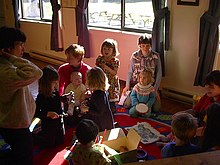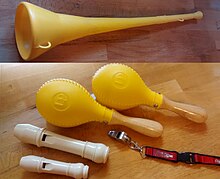174:
music classes and participate in tactile and parent assisted activities. With parental assistance, infants can partake in body movement and rhythm exercises to sung songs and recorded music and through play. As these children develop independent motor skills, they progress to doing these activities on their own. Infants and toddlers are often encouraged to sing and explore rhythm through body movements and percussion instruments such as egg shakers, drums, and xylophones. As young children progress, activities can include concepts that introduce counting, solfege, and notation. Some programs then allow for young children to shift easily into more formalized dance and instrumental instruction starting at a very early age.
60:
51:
31:
39:
69:
225:: Based on the principles of "Mother Tongue", or the belief that music learning builds on the principles of language learning and therefore needs to start at a very early age, this method introduces music to children as they would their native language. Listening, imitation, and repetition are key components.
140:
group of little friends as well. Music also allows a smooth transitioning throughout daily activities, whether it be at home or in a classroom setting children get the idea of the following activity. Allowing children to play with others, including adults or older siblings also gives them a boost of
205:
Several pedagogical approaches exist which promote specific methods of training young children in music, many of which share commonalities, such as music and rhythm development through body movements, folk songs, aural training, and the belief that music literacy from an early age is beneficial. They
148:
and body awareness, as well as extending their vocabulary in general. Additionally, by extending children’s vocabulary they can also learn of different cultural music and languages, for some the benefit to integrate home within their care-giving setting. Cognitive benefits also include learning how
173:
Most early childhood music education is accomplished through parent or teacher guided interactive play. Prenatal activities can include singing and playing music so that it can be heard in the womb and continued on with newborns. From birth, children can listen to music and observe other children in
54:
Children's action songs offer rich learning experiences that have children memorize information in various ways. Children learn musically, vocally, visually, and physically while listening to children's action songs. Combining these learning modes in children's action songs helps improve information
63:
Fingerplays and action rhymes are short poems, lyrics, chants, or stories that can be used as musical experiences for your child to learn through hand motions—the lyrics pair words and actions, which correspond to hand movements. For centuries, parents, grandparents, and instructors, the keepers of
169:
Music education for young children is offered privately through classes and music organizations or integrated into educations private and public schools. Activities and classes can start as early as prenatally or newborn and in private education, music programs are often integrated in as early as
139:
abilities, cognitive benefits, and physical benefits. Socially, children have the opportunity to learn how to take turns and play with others while still playing individually, for example a band of little players each playing their instrument but yet looking at the big picture of playing with a
240:
Studies done on children who have had a musical background, have shown that it increases brain function as well as brain stimulation. When children are exposed to music from other countries and cultures, they are able to learn about the instrument while at the same time being educated about a
490:
170:
preschool. Early childhood music education in public school settings widely varies, but music programs have been established in some schools starting in kindergarten even in remote areas.
626:
596:
591:
34:
Mamatoto
Playgroup, Lions' Club Hall. Mamatoto in Swahili means "motherbaby". Mamatoto groups have been started throughout the world to support this unit of mother and baby.
213:: This approach encourages children to learn music through a combination of movement, rhythm, and playing instruments. It focuses on improvisation and creative expression.
586:
161:
grow rapidly by learning how to move their body to music, moving their bodies to actions of a song, and as they grow by learning how to hold and play an instrument.
219:: This method uses solfege syllables and hand signs to teach pitch and rhythm. It starts with folk songs and emphasizes singing before introducing instruments.
636:
601:
302:
17:
153:, memorizing different songs for different experiences, and simply memorizing songs and their pace and tone. Physically, children’s all around
231:: This approach emphasizes the connection between music and movement. Children explore rhythm and musical concepts through physical activities.
278:
470:
368:
369:"Musicians' Enhanced Neural Differentiation of Speech Sounds Arises Early in Life: Developmental Evidence from Ages 3 to 30"
430:
396:
197:
for rhythm exercises. This is usually only done private at home because of the noise regulations in school courses.
59:
131:
provides for children as they continue to grow. The benefits that young children acquire through music include
463:
190:
77:
50:
136:
667:
662:
520:
456:
285:
418:
177:
Many children like making very loud music respectively noise. In this case, it is common to use
38:
515:
422:
412:
30:
228:
104:
8:
616:
326:
255:
150:
631:
576:
426:
392:
154:
551:
158:
43:
216:
581:
525:
505:
500:
495:
479:
303:"communityplaythings.com - Learning Through Music: The Support of Brain Research"
250:
116:
611:
546:
541:
210:
656:
606:
566:
556:
222:
132:
621:
571:
186:
141:
81:
347:
561:
178:
112:
99:
is an educational program introducing children in a playful manner to
64:
history, have fashioned and passed down fingerplays and action rhymes.
641:
410:
144:. Also, different songs show children the different words used for
194:
73:
448:
182:
145:
100:
85:
200:
279:"Beyond Twinkle, Twinkle Using Music with Infants and Toddlers"
68:
128:
108:
439:
72:
Some very loud instruments that are suitable for children:
411:
444:. Bourbonnais, IL: Olivet Nazarene University Press, Inc.
55:
memorization, recall, and fine and gross motor skills.
491:Développement des publics de la musique au Québec
654:
406:. New York, NY: Harper Collins Publishers, Inc.
391:, Australian Broadcasting Tribunal, Melbourne.
149:to count, recognizing sequencing and patterns,
464:
440:Chastain, Jacob; Rev. Jessica Brooks (2007).
201:Pedagogies of early childhood music education
471:
457:
414:Raising Musical Kids: A Guide for Parents
67:
58:
49:
37:
29:
401:
164:
14:
655:
452:
273:
271:
478:
24:
511:Music education for young children
97:Music education for young children
25:
679:
268:
327:"Suzuki Prenatal and Baby Years"
18:Early childhood music education
404:The Mozart Effect for Children
361:
348:"Juneau, Alaska Music Matters"
340:
319:
295:
235:
13:
1:
261:
241:different part of the world.
127:There are many benefits that
7:
389:Young Australians and Music
376:brainvolts.northwestern.edu
307:www.communityplaythings.com
244:
122:
10:
684:
27:Subarea of music education
534:
486:
442:Lessons Learned in Larsen
137:emotional self-regulating
587:Barbara Reeder Lundquist
521:Psychoanalysis and music
387:Agardy, Susanna (1985),
419:Oxford University Press
516:Online music education
189:, the head joint of a
93:
65:
56:
47:
35:
402:Campell, Don (2000).
115:. It is a subarea of
71:
62:
53:
42:Suzuki Violin group,
41:
33:
229:Dalcroze Eurhythmics
165:Forms and activities
76:, Soprano and alto
617:Alphons Silbermann
256:Music and movement
151:phonemic awareness
94:
66:
57:
48:
36:
650:
649:
632:Christopher Small
577:Maurice Halbwachs
159:fine motor skills
16:(Redirected from
675:
637:Norman Stanfield
552:Howard S. Becker
473:
466:
459:
450:
449:
445:
436:
407:
380:
379:
373:
365:
359:
358:
356:
354:
344:
338:
337:
335:
333:
323:
317:
316:
314:
313:
299:
293:
292:
290:
284:. Archived from
283:
275:
44:Suzuki Institute
21:
683:
682:
678:
677:
676:
674:
673:
672:
668:Sociomusicology
663:Music education
653:
652:
651:
646:
582:David G. Hebert
530:
526:Sociomusicology
506:Music education
501:Music community
496:Ethnomusicology
482:
480:Sociomusicology
477:
433:
384:
383:
371:
367:
366:
362:
352:
350:
346:
345:
341:
331:
329:
325:
324:
320:
311:
309:
301:
300:
296:
288:
281:
277:
276:
269:
264:
251:Music education
247:
238:
203:
181:like very loud
167:
125:
117:music education
28:
23:
22:
15:
12:
11:
5:
681:
671:
670:
665:
648:
647:
645:
644:
639:
634:
629:
624:
619:
614:
612:Charles Seeger
609:
604:
602:Joseph Schloss
599:
594:
589:
584:
579:
574:
569:
564:
559:
554:
549:
547:Jacques Attali
544:
542:Theodor Adorno
538:
536:
535:Notable people
532:
531:
529:
528:
523:
518:
513:
508:
503:
498:
493:
487:
484:
483:
476:
475:
468:
461:
453:
447:
446:
437:
431:
408:
399:
382:
381:
360:
339:
318:
294:
291:on 2015-08-10.
266:
265:
263:
260:
259:
258:
253:
246:
243:
237:
234:
233:
232:
226:
220:
214:
211:Orff Schulwerk
202:
199:
166:
163:
124:
121:
26:
9:
6:
4:
3:
2:
680:
669:
666:
664:
661:
660:
658:
643:
640:
638:
635:
633:
630:
628:
627:John Shepherd
625:
623:
620:
618:
615:
613:
610:
608:
607:Alfred Schutz
605:
603:
600:
598:
595:
593:
590:
588:
585:
583:
580:
578:
575:
573:
570:
568:
567:Norbert Elias
565:
563:
560:
558:
557:Georgina Born
555:
553:
550:
548:
545:
543:
540:
539:
537:
533:
527:
524:
522:
519:
517:
514:
512:
509:
507:
504:
502:
499:
497:
494:
492:
489:
488:
485:
481:
474:
469:
467:
462:
460:
455:
454:
451:
443:
438:
434:
432:0-19-512923-7
428:
424:
420:
416:
415:
409:
405:
400:
398:
397:0-642-09805-0
394:
390:
386:
385:
377:
370:
364:
349:
343:
328:
322:
308:
304:
298:
287:
280:
274:
272:
267:
257:
254:
252:
249:
248:
242:
230:
227:
224:
223:Suzuki Method
221:
218:
217:Kodály Method
215:
212:
209:
208:
207:
198:
196:
192:
188:
184:
180:
175:
171:
162:
160:
156:
152:
147:
143:
138:
134:
133:social skills
130:
120:
118:
114:
111:, motion and
110:
106:
102:
98:
91:
87:
83:
80:head joints,
79:
75:
70:
61:
52:
45:
40:
32:
19:
622:Georg Simmel
597:John Mueller
592:Peter Martin
510:
441:
417:. New York:
413:
403:
388:
375:
363:
351:. Retrieved
342:
330:. Retrieved
321:
310:. Retrieved
306:
297:
286:the original
239:
204:
187:pea whistles
176:
172:
168:
126:
96:
95:
89:
84:, very loud
572:Simon Frith
421:. pp.
236:World music
179:noisemakers
142:self-esteem
82:pea whistle
657:Categories
562:Tia DeNora
312:2015-07-13
262:References
113:organology
642:Max Weber
206:include:
195:vuvuzelas
245:See also
191:recorder
146:emotions
123:Benefits
78:recorder
74:vuvuzela
183:maracas
101:singing
86:maracas
429:
395:
353:12 May
332:12 May
105:speech
90:LP 281
423:18–33
372:(PDF)
289:(PDF)
282:(PDF)
155:gross
129:music
109:music
427:ISBN
393:ISBN
355:2013
334:2013
157:and
193:or
659::
425:.
374:.
305:.
270:^
185:,
135:,
119:.
107:,
103:,
472:e
465:t
458:v
435:.
378:.
357:.
336:.
315:.
92:)
88:(
46:.
20:)
Text is available under the Creative Commons Attribution-ShareAlike License. Additional terms may apply.




